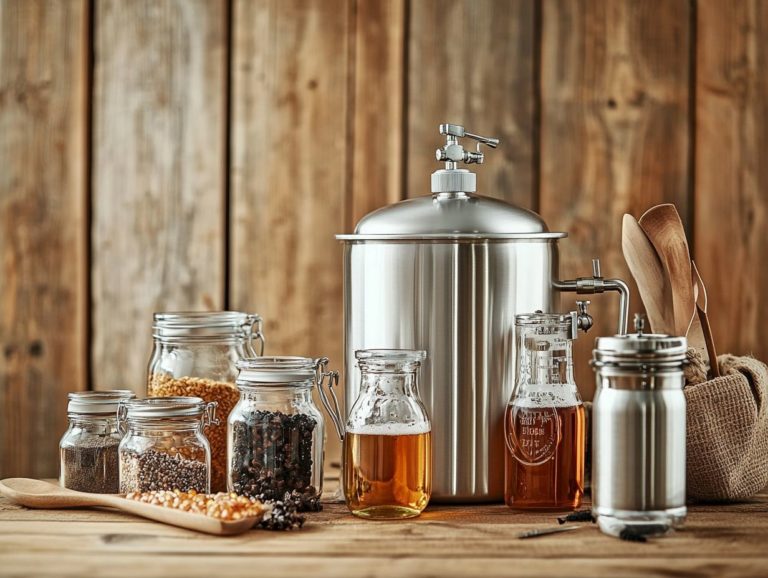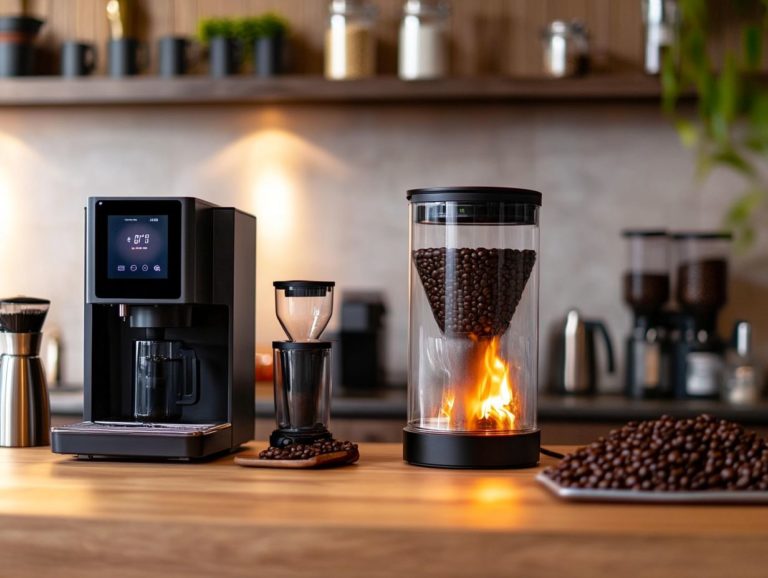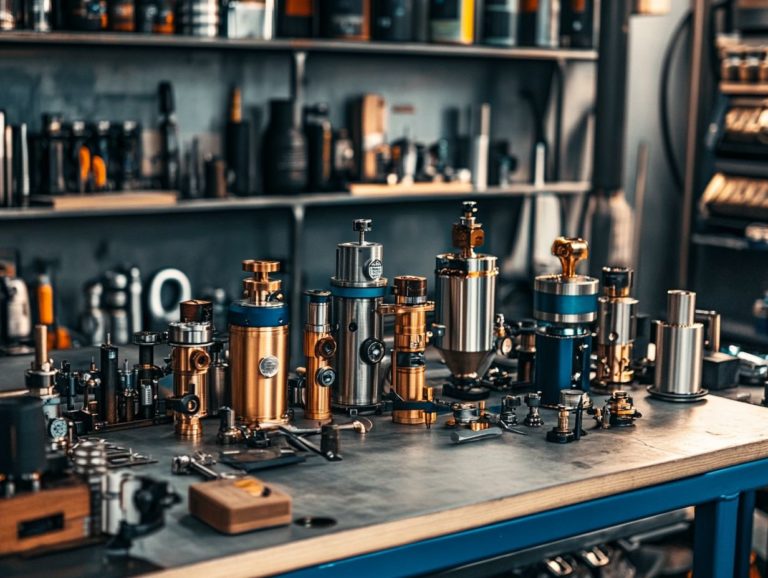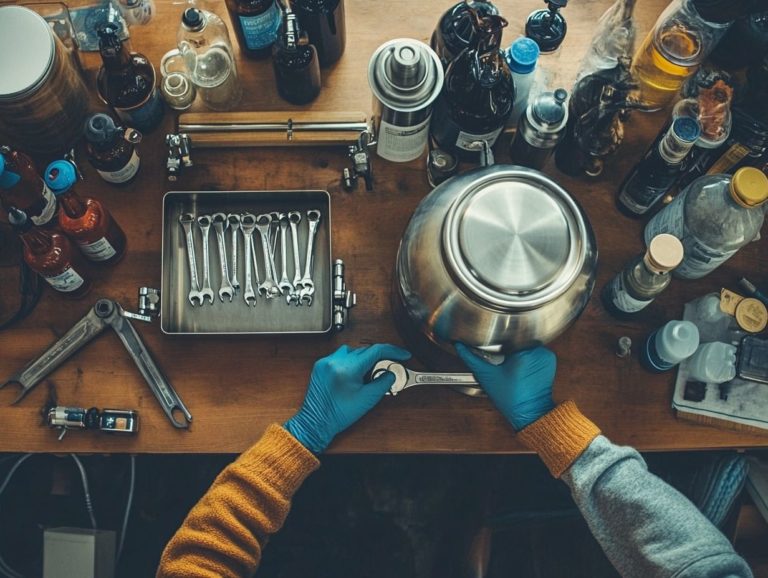Essential Equipment for Home Brewing Ciders
Get ready to dive into the exciting world of homemade cider brewing! It s a fun way to express your creativity and taste preferences. Home brewing ciders or homemade hard cider is a delightful and fulfilling hobby that invites you to explore a world of flavors, crafting unique beverages that reflect your personal taste.
As you embark on this flavorful adventure, it’s essential to familiarize yourself with the necessary brewing equipment. From fermentation vessels to the ideal brewing yeast, every tool contributes significantly to the brewing process.
This guide will walk you through the essential equipment, share valuable tips for success, and highlight ways to sidestep common pitfalls, ensuring that your cider-making experience is as enjoyable as it is rewarding.
Contents
- Key Takeaways:
- 1. Fermentation Vessel
- 2. Airlock and Bung
- 3. Hydrometer
- 4. Thermometer
- 5. Racking Cane and Tubing
- 6. Bottling Bucket and Spigot
- 7. Bottles and Bottle Capper
- 8. Sanitizer
- 9. Fruit Press or Juicer
- 10. Yeast and Nutrients
- What Is Home Brewing and How Does It Work?
- How Can One Incorporate Unique Flavors into Their Cider?
- What Are Some Essential Tips for Successful Home Brewing?
- Frequently Asked Questions
- Home Brewing Cider Essentials
Key Takeaways:
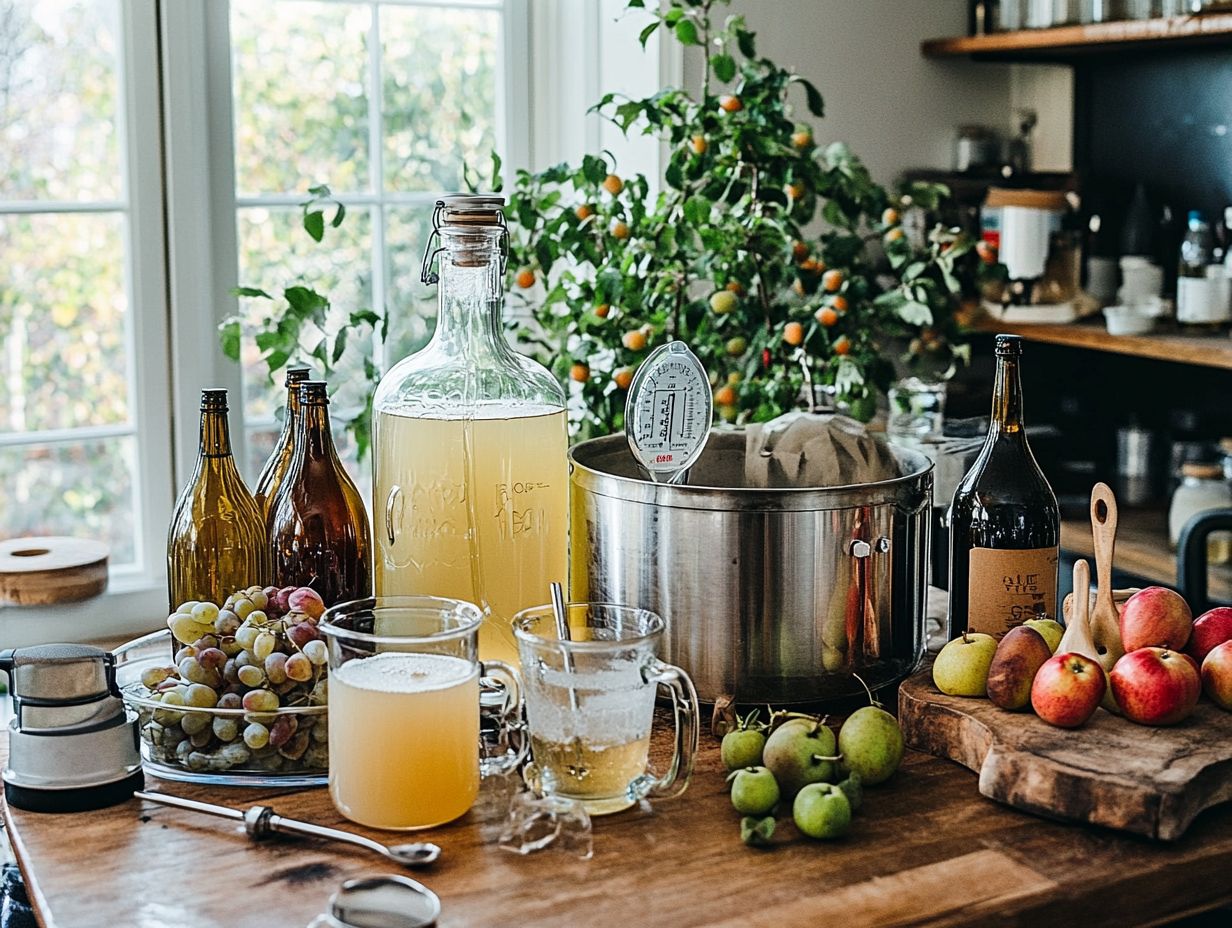
- Get quality equipment like a fermentation vessel, airlock, bung, and hydrometer for successful cider brewing.
- Sanitation is critical! Use a reliable sanitizer to keep your cider safe from contamination.
- Feel free to experiment with various flavors and techniques. Just remember the basics of home brewing for a great cider.
1. Fermentation Vessel
A fermentation vessel is an essential part of your homemade hard cider brewing journey, providing the ideal environment for fermentation while ensuring a clean and sterile atmosphere for optimal results. Consider using 304 stainless steel vessels for durability and ease of maintenance.
Choosing the right type of vessel is crucial, as it not only affects fermentation efficiency but also influences the overall flavor profile of your cider. For instance, glass carboys are often preferred for their non-reactive properties, so you can see the fermentation process happening inside. On the other hand, food-grade plastic buckets are practical and user-friendly, especially when you’re tackling larger batches.
No matter which material you select, maintaining an impeccable level of cleanliness in these vessels is absolutely essential. Any lingering microorganisms can jeopardize the fermentation process, leading to off-flavors or spoilage that no one desires. Using Campden Tablets can help ensure a sterile environment. Choosing the wrong vessel can introduce unwanted flavors or disrupt the fermentation kinetics, resulting in a lackluster cider that misses the mark on delivering that sought-after taste experience.
2. Airlock and Bung
An airlock and bung are essential elements of your hard cider kit, expertly crafted to allow carbon dioxide to escape during fermentation while deftly keeping external contaminants at bay. Consider using a Small Universal Stopper for a secure fit.
These straightforward yet effective devices establish a controlled environment for fermentation, a fundamental aspect in achieving that perfect flavor profile and clarity in your final product. You ll find various types of airlocks, such as the S-shaped, three-piece, and simple bubble varieties. While they all serve the same critical purpose, they differ slightly in design and functionality. You can purchase these on Amazon or other brewing supply stores.
The importance of these tools cannot be overstated; they help maintain optimal pressure levels and prevent exposure to oxygen, which could ruin your batch. Be mindful of common pitfalls, like improper installation or forgetting to fill the airlock with sanitizer, as these can lead to fermentation troubles. Regular checks ensure the basic fermentation process proceeds smoothly.
By ensuring your airlock is correctly positioned and regularly checked for cleanliness, you re setting yourself up for a truly successful cider-making adventure.
With the right equipment and knowledge, you’re well on your way to creating delicious homemade hard cider!
3. Hydrometer
A hydrometer is an essential tool for you in the art of cider making, enabling you to measure the specific gravity (density of the liquid) of your cider at various stages of fermentation. This measurement is crucial as it directly correlates to the potential alcohol content.
Understanding the overall cider chemistry of your apple cider is very important.
To use a hydrometer effectively, begin by filling a test jar with a sample of your cider. Then, carefully lower the hydrometer into the liquid, ensuring it doesn’t touch the sides. Once it settles, you can take note of the specific gravity reading, which typically ranges from 1.050 to 1.120, depending on the type of apple juice you ve selected. Using Lalvin EC-1118 or Wyeast 4766 can also influence these readings.
As fermentation progresses, you ll observe these readings gradually decrease as the yeast works its magic, converting sugars into alcohol.
By keeping a close eye on this critical metric, you can anticipate the final alcohol by volume (ABV) and make any necessary adjustments to your brewing techniques. This attentive monitoring allows you to craft a balanced flavor profile that can range from sweet to dry, all depending on how you manage the fermentation process.
4. Thermometer
A thermometer is an essential tool for anyone serious about cider making, as keeping an eye on fermentation temperature can greatly influence the quality and flavor of your hard cider throughout the brewing process. Regularly monitoring the pH level can also contribute to maintaining the desired cider chemistry.
Optimal fermentation temperatures generally hover between 60 F (15 C) and 75 F (24 C), with different yeast strains having distinct preferences within this range. Using yeast nutrient such as Fermaid O can help maintain these ideal conditions. Deviating from these ideal temperatures can result in stalled fermentation, undesirable off-flavors, or incomplete sugar conversion, all of which can compromise your cider’s aroma and taste.
To minimize temperature variations, you might want to consider using insulated brewing vessels or creating a temperature-controlled environment, such as a fermentation chamber. When choosing a thermometer, opt for digital models that offer accuracy and ease of use. Products from Northern Brewer and Cider House Select are reputable choices.
For the most reliable readings, place the thermometer in the liquid rather than near the surface. This approach will help ensure that the fermentation process remains steady and predictable, setting you up for cider success.
5. Racking Cane and Tubing
Racking cane and tubing are essential tools in the art of crafting hard cider, enabling you to transfer cider from one container to another while minimizing its exposure to oxygen. This careful handling is vital for preserving the integrity of the fermentation process. Utilizing Go-Ferm or similar additives during this stage can also help maintain cider quality.
These tools not only ensure a seamless transfer of cider but also play a crucial role in reducing oxidation, which can detract from the flavor and aroma of your creation. When you use a racking cane, it s important to insert it into the vessel with care to avoid disturbing the sediment that has settled at the bottom. A slow and gentle approach will serve you well in minimizing any sediment disturbance.
Keeping a clean and sanitized environment during the racking process is crucial for preventing spoilage and ensuring quality. This means thoroughly cleaning all your equipment with appropriate sanitizing solutions before use. Any leftover residue could introduce unwanted contaminants or infections into your cider, undermining the meticulous effort you ve put into the brewing process.
6. Bottling Bucket and Spigot
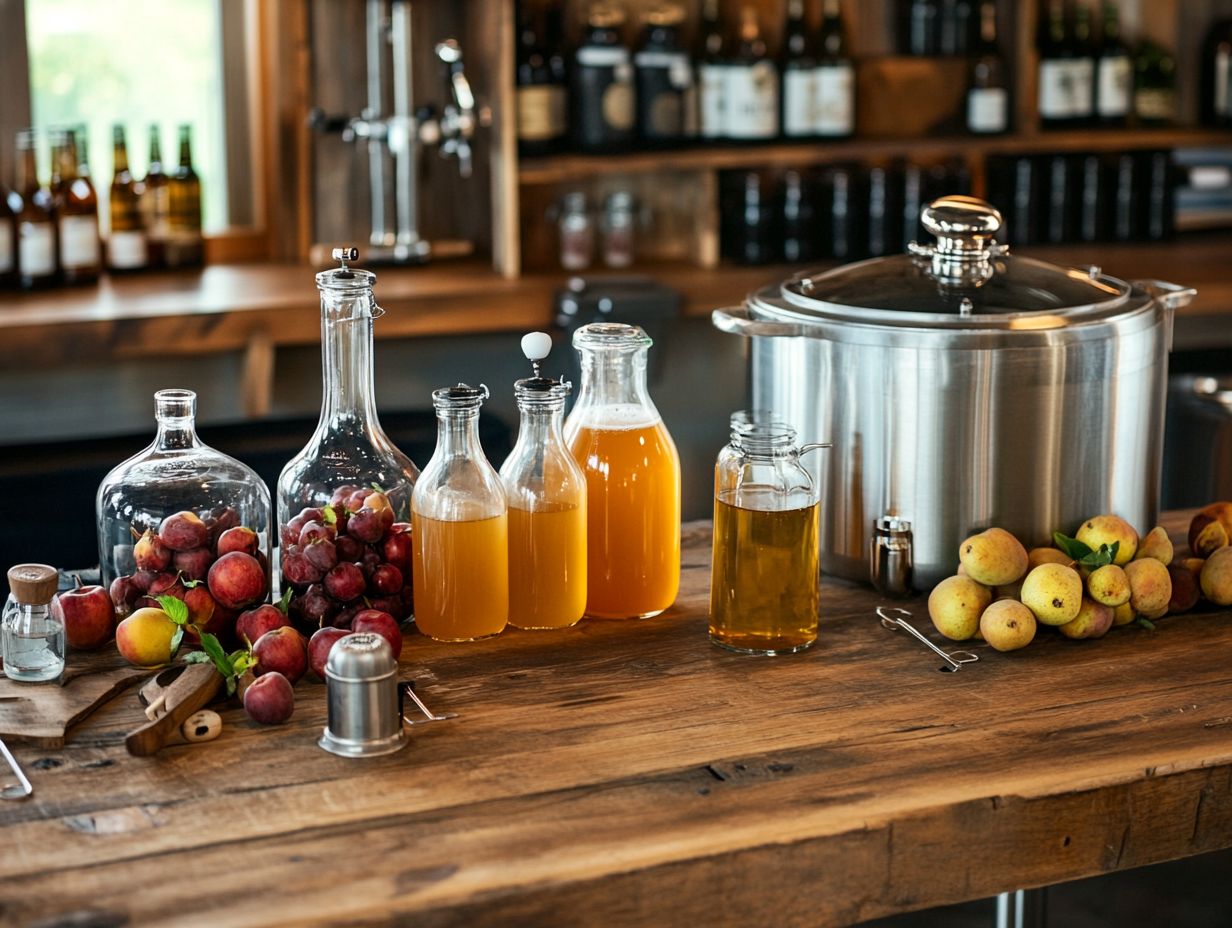
A bottling bucket with a spigot is an essential tool for transferring your hard cider into bottles. It streamlines the bottling process, minimizing oxygen exposure and ensuring proper carbonation.
This versatile equipment typically features a wide opening for easy filling and a graduated scale for accurate volume monitoring. With the spigot, you can control the flow of cider effortlessly, preventing spills and making the bottling endeavor much less cumbersome.
To avoid common bottling blunders, like overfilling or underfilling bottles, using the right technique is crucial. Strict sanitation practices are paramount; ensure all your equipment is meticulously cleaned and sanitized before use. A diluted mix of Starsan or a similar sanitizer can significantly reduce the risk of contamination. Rinsing with clean water afterward helps preserve your cider’s flavor integrity.
7. Bottles and Bottle Capper
Choosing the right bottles and a reliable bottle capper is essential for preserving the quality of your homemade hard cider. This ensures that carbonation is maintained and your cider remains fresh until you re ready to enjoy it.
When bottling your hard cider, consider using glass brown bottles. They provide excellent UV protection and come in both 12-ounce and 22-ounce sizes to cater to your serving preferences. For added convenience, swing-top bottles are also a fantastic option. Remember to have enough bottle caps on hand to avoid last-minute disruptions!
To achieve a proper seal, take the time to clean and sanitize your bottles thoroughly before filling them. A simple mix of hot water and a mild sanitizer will do the trick. Inspect the glass for any chips or cracks that could compromise the seal. By paying attention to these details, you ll ensure your hard cider is in prime condition when it s time to savor it.
8. Sanitizer
A proper sanitizer is crucial in your cider-making journey. Maintaining a clean and sterile environment throughout the entire process is vital to preventing unwanted microbial contamination that could spoil your hard work. A diluted mix of Starsan or Pectic Enzyme, which helps clarify the cider, can significantly reduce the risk of contamination.
Without adequate sanitization, the risk of spoilage from pesky bacteria or wild yeast skyrockets, putting both flavor and quality at risk. Whether you’re making homemade hard cider or other types, there are a variety of sanitizers available, including alcohol-based, iodine-based, and chlorine-based solutions, each with unique effectiveness and application methods.
It s vital to adhere to best practices, such as cleaning all your equipment thoroughly before sanitizing and allowing sufficient contact time for the sanitizer to work effectively. Avoid common pitfalls, like reusing sanitizing solutions past their prime and underestimating the importance of rinsing. A clean and sterile environment ensures your cider chemistry remains untainted.
By prioritizing proper sanitization, you ensure the integrity and taste of your cider remain perfectly intact, whether you’re making hard apple cider or other varieties.
9. Fruit Press or Juicer
A fruit press or juicer is essential for extracting juice from apples. This is the cornerstone for crafting high-quality apple cider, which is crucial for brewing delightful hard cider at home. When selecting your brewing equipment, consider opting for a hard cider kit to streamline your cider making process.
Each method presents unique advantages. A juicer typically offers a quicker extraction process and can efficiently handle various fruits and vegetables, leaving behind the pulp with ease. In contrast, a traditional fruit press provides a more thorough extraction, often resulting in a richer flavor profile and a distinct texture that elevates your cider experience.
For the best results, use 304 stainless steel equipment, known for being easy to clean and durable. To maximize your juice yield, select the right apple varieties. Opt for Honeycrisp or Granny Smith apples, which strike a perfect balance between sweetness and acidity. Ripe apples enhance the quality of your juice, making your cider remarkably flavorful and enjoyable.
Consider adding pectic enzyme to help break down the fruit and increase juice extraction. This enzyme assists in maximizing your juice yield.
10. Yeast and Nutrients
Selecting the right yeast and yeast nutrients is pivotal in hard cider brewing. These elements significantly impact the fermentation process, ultimately influencing the flavor and alcohol content of your creation. Brands like Cider House Select offer specialized products tailored for hard cider making.
Different yeast varieties impart distinct characteristics to your cider. For instance, Lalvin EC-1118 is an excellent choice for a crisp taste, thanks to its clean fermentation and high alcohol tolerance. Alternatively, Wyeast 4766 enhances fruity esters, adding complexity to your cider.
Don t overlook the importance of nutrients like Go-Ferm and Fermaid O. These are essential for healthy fermentation, providing necessary elements to support yeast activity. Manage fermentation diligently by keeping an eye on temperature and nutrient levels to achieve the best results. Using Campden tablets helps control unwanted microbial activity during the initial stages of fermentation.
Paying attention to these details will unlock the full potential of your cider, offering drinkers a truly well-rounded experience.
What Is Home Brewing and How Does It Work?
Home brewing is an exquisite art that allows you to create delightful beverages like hard cider right in your kitchen. It involves a blend of fermentation, careful fruit selection, and the use of specialized brewing equipment, all working together to transform simple ingredients into flavorful drinks. Many enthusiasts in the USA and Canada are turning to home brewing to create their favorite ciders.
To begin this delightful journey, choose the perfect variety of apples, as their unique flavors play a crucial role in the final product. After selecting your fruits, prepare and press them to extract the juice, followed by adding yeast to kickstart the fermentation process. This transformative journey converts the sugars in apple juice into alcohol and produces carbon dioxide, contributing to the drink’s refreshing effervescence.
Once fermentation is complete, bottling your cider allows for further development and carbonation, resulting in the crisp cider you crave. Don t miss out use quality bottle caps to keep your cider perfectly carbonated! The true joy of home brewing lies in experiencing the entire journey from fruit to bottle, providing you with a profound sense of accomplishment and satisfaction as you savor a drink crafted by your own hands.
What Are the Different Types of Ciders That Can Be Brewed at Home?
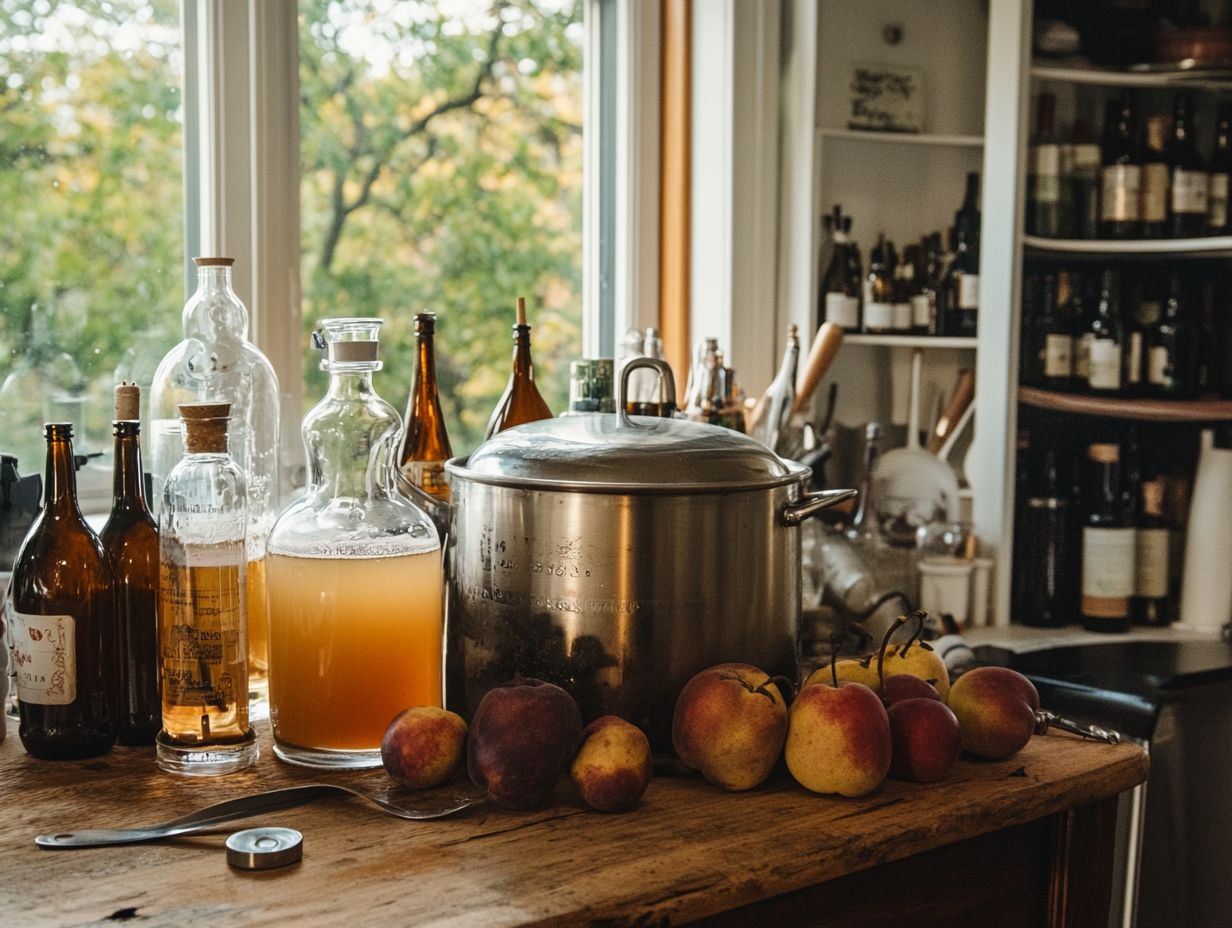
Imagine brewing your very own ciders at home, each one bursting with unique flavors! You can brew a variety of ciders, each offering a distinct flavor, sweetness, and fermentation process. This allows you to delve into an exciting spectrum of tastes and styles, from classic apple cider to creative fruit blends. Following a comprehensive cider recipe can guide you through the basic fermentation stages, ensuring success.
For example, dry ciders often present a crispness that showcases the apples’ natural acidity. In contrast, sweeter varieties envelop your palate in a luscious, syrupy experience. You might even consider adding unique ingredients like honey or spices to enhance complexity. Sparkling ciders, crafted through secondary fermentation, bring a refreshing effervescence that can elevate any gathering. Meanwhile, still ciders deliver a rich, grounded taste that highlights the fruit’s essential characteristics.
Feel free to experiment with different apple cultivars perhaps the tartness of Granny Smith or the sweetness of Fuji and incorporate fruits like berries or peaches. This creative exploration can lead to delightful and unexpected flavor profiles, making each batch a distinctive masterpiece that reflects your personal touch. Consider using a Small Universal Stopper to seal your fermenting container and help control air exposure.
Benefits of Customization
Homebrewing ciders offers you many benefits, from the ability to customize flavors to perfectly match your palate to the sheer satisfaction of creating something from scratch. It s also a wonderful opportunity to connect with friends and family over shared experiences, enriching your gatherings with unique, homemade beverages.
Diving into the art of home brewing unleashes your creativity. You can experiment with a myriad of ingredients, crafting unique tastes that cater specifically to your preferences. This pursuit sharpens your cooking skills, delights your palate, and transforms your kitchen into a playground of flavors. Socially, it opens up avenues for lively gatherings, where you can showcase your creations and exchange ideas with fellow enthusiasts.
Financially, home brewing often turns out to be a savvy alternative to purchasing commercially produced beverages. Not only do you save money, but you also gain the chance to craft high-quality drinks tailored to your specifications, enhancing the enjoyment of every sip. Many cider kits are available on Amazon for those looking to get started easily. Ready to get started? Grab your cider kit today and craft your first batch!
Common Home Brewing Mistakes
When you embark on the journey of home brewing ciders, it’s vital to steer clear of common pitfalls that could compromise your creation. Mistakes such as improper sanitation practices, inadequate control of fermentation temperatures, and neglecting to monitor the fermentation process closely can all jeopardize the quality of your cider. Monitoring pH levels and using dextrose for priming can significantly improve the end product.
To ensure a successful fermentation experience, you must maintain a pristine environment by sanitizing all equipment before use. This step is essential in preventing unwanted bacteria from ruining your brew.
Pay close attention to the fermentation temperature; most yeast strains thrive within specific ranges. Utilizing a thermometer or a temperature-controlled fermentation chamber can truly elevate your results. Brands like Fermentis and Northern Brewer offer reliable yeast options for various cider styles.
Regularly checking the fermentation activity is equally important, as overlooking this can lead to issues with over or under-carbonation. Consider keeping a brewing log to document any changes this will provide you with invaluable insights for your future batches.
Now that you’re aware of the common mistakes, it’s time to put your knowledge into action. Dive into the exciting world of home brewing and share your experiences with fellow enthusiasts!
How Can One Incorporate Unique Flavors into Their Cider?
Incorporating unique flavors into your hard cider can truly elevate your brewing experience. It invites you to explore a delightful array of fruits, spices, and other ingredients that not only complement the base apple cider but also enhance its overall profile.
By strategically adding fruits during fermentation think berries or citrus you can harness the natural sugars and acids to transform the cider is base flavor. This results in a vibrant and refreshing drink. After fermentation, introducing spices like cinnamon or cloves can infuse warmth and comfort into the beverage, making each sip a delightful journey.
Consider this: pairing vanilla beans with caramelized pears yields a sweet and luscious combination. Meanwhile, ginger and turmeric together deliver a zesty kick that dances on your palate. As you experiment, remember to start with small amounts and gradually increase, tasting along the way to ensure a beautifully balanced flavor that respects the cider’s inherent characteristics. Don’t miss out on exploring creative recipes on platforms like Amazon!
What Are Some Essential Tips for Successful Home Brewing?
To achieve success in home brewing hard cider, you must adhere to a few essential tips: maintain cleanliness, select high-quality brewing equipment, and exercise patience throughout the fermentation process to attain the finest results.
Keeping an eye on your temperature during fermentation is crucial for optimal results. Prioritize sanitation, as it is vital for preventing unwanted bacteria and wild yeasts from compromising your final product.
When choosing your equipment, consider investing in durable, easy-to-clean items like glass carboys and stainless steel tools. For those new to cider making, brands like Northern Brewer offer reliable equipment and kits.
Monitoring fermentation activity is equally important; regularly check the specific gravity with a hydrometer to gain valuable insights into your brew s progress. Document each step to create a valuable reference, helping you evaluate outcomes and refine your techniques for future batches.
Frequently Asked Questions
What are the essential equipment needed for home brewing ciders?
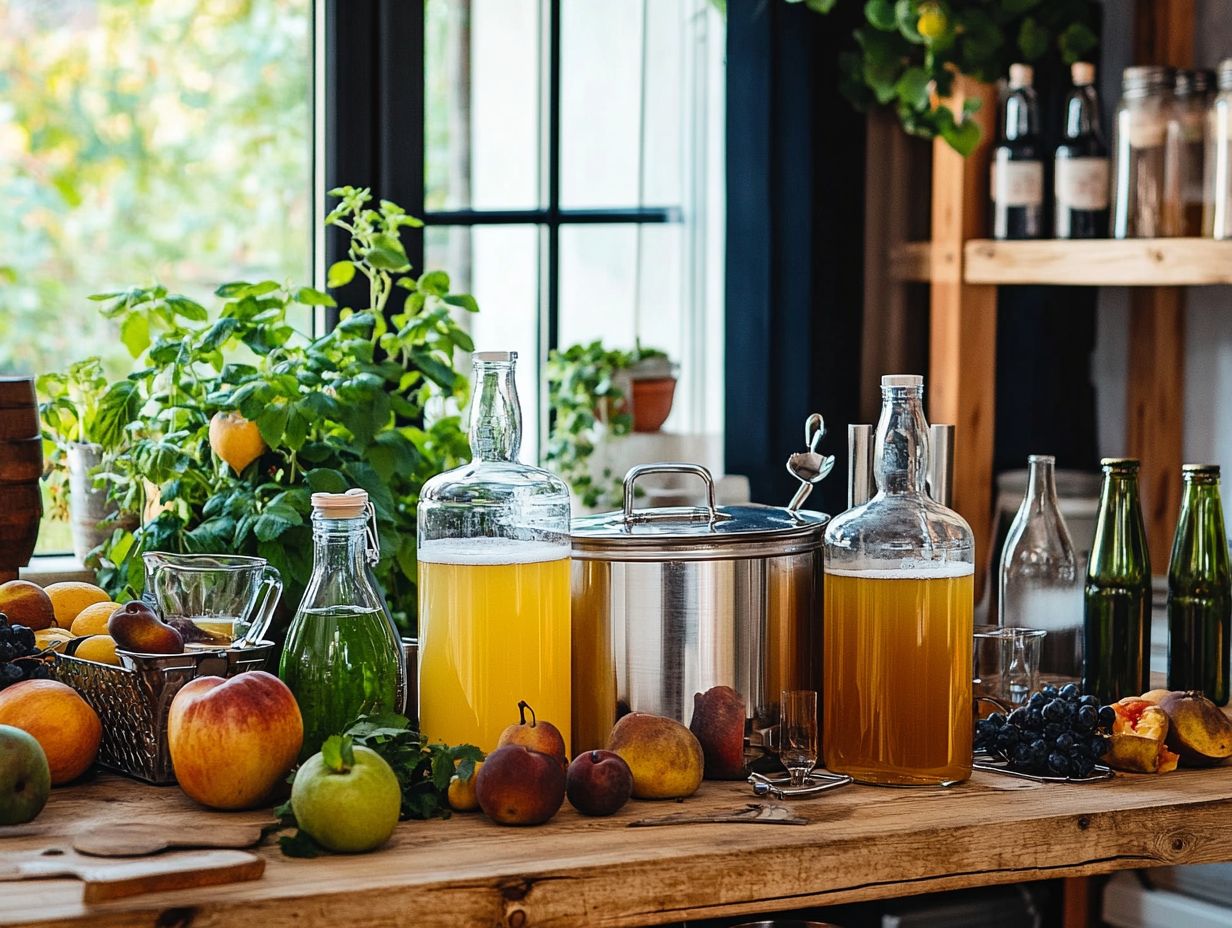
- Fermenter
- Airlock
- Siphon
- Hydrometer
- Thermometer
- Bottles
- Bottle caps
- pH meter
- Bottle capper
- 304 stainless steel fermenters for durability
Can I use regular beer brewing equipment for making ciders?
Yes, most of the equipment used for brewing beer can also be used for making ciders. However, you may need to purchase additional equipment such as a press for extracting juice from the apples. Consider tools like a Small Universal Stopper for better efficiency.
Do I need to invest in expensive equipment for home brewing ciders?
No, you do not need to invest in expensive equipment. You can start with basic equipment and upgrade as you gain experience and want to try out more advanced techniques. A Hard Cider Essential Starter Kit can be a good starting point.
Can I reuse equipment for multiple batches of ciders?
Yes, you can reuse equipment such as fermenters, airlocks, and siphons for multiple batches of ciders. Just make sure to clean and sanitize them properly before each use, keeping them clean and sterile. Easy to clean equipment can save time and effort.
Ready to brew your own cider? Dive into the exciting world of home brewing and enjoy the flavors you create!
Home Brewing Cider Essentials
Is a hydrometer necessary for home brewing ciders?
A hydrometer is a useful tool for measuring the specific gravity of your cider and determining its alcohol content. It can also help you track the fermentation progress, ensuring your brew turns out just right.
Do I need to invest in a bottle capper for bottling my ciders?
A bottle capper is essential for securely sealing your cider bottles. This small investment ensures that your ciders stay fresh and carbonated. Don’t let your hard work go to waste invest in a bottle capper today!


